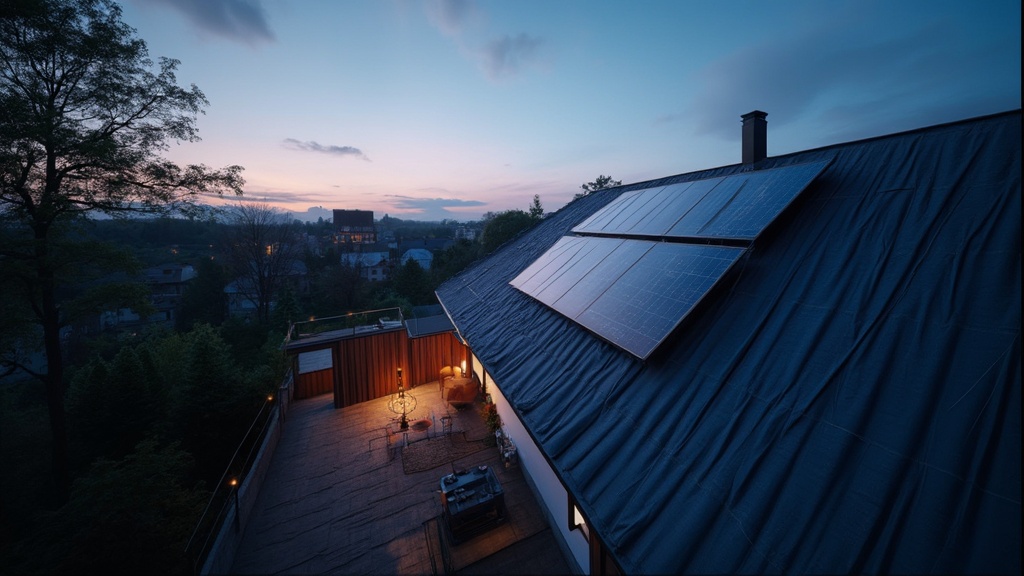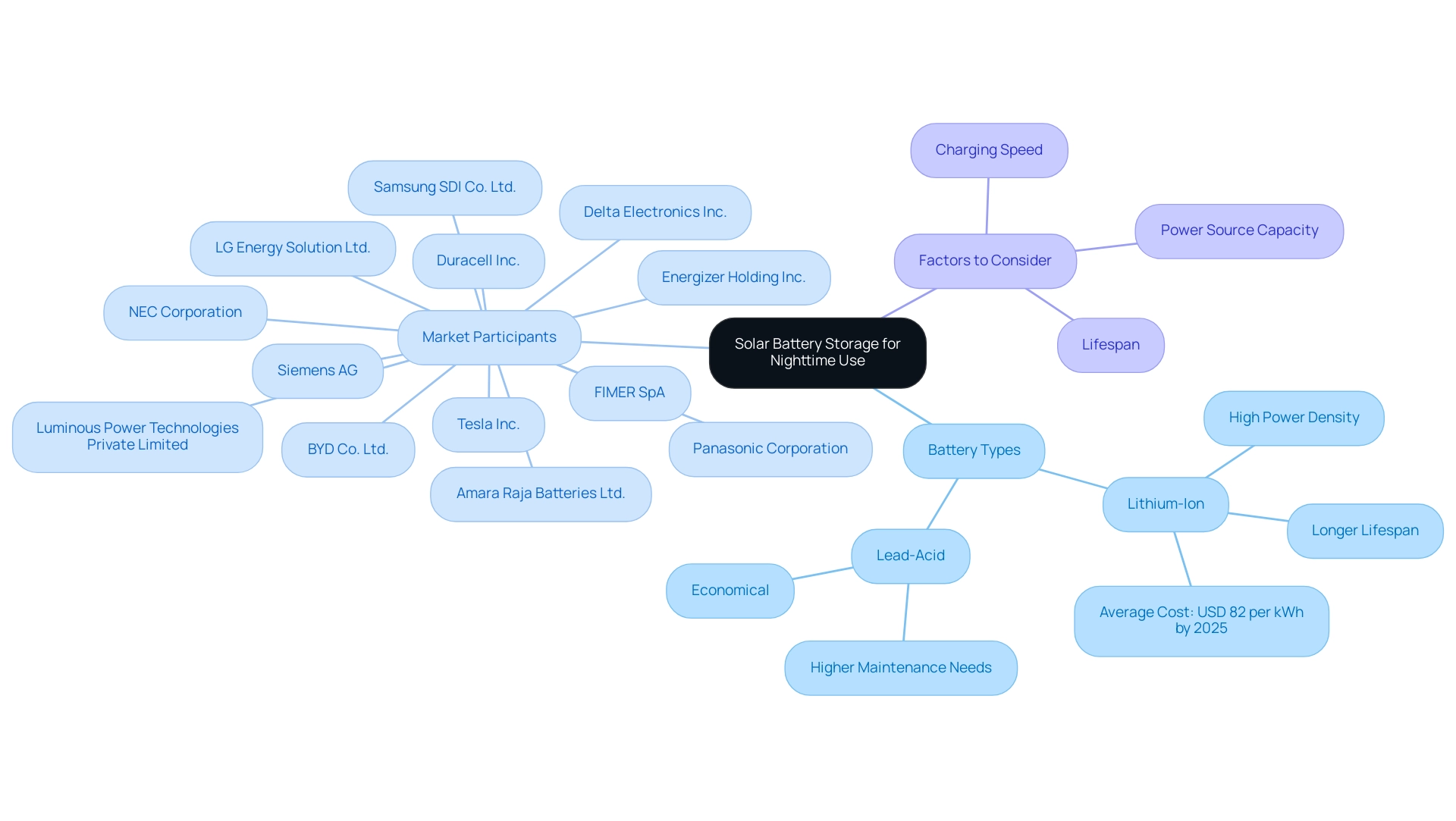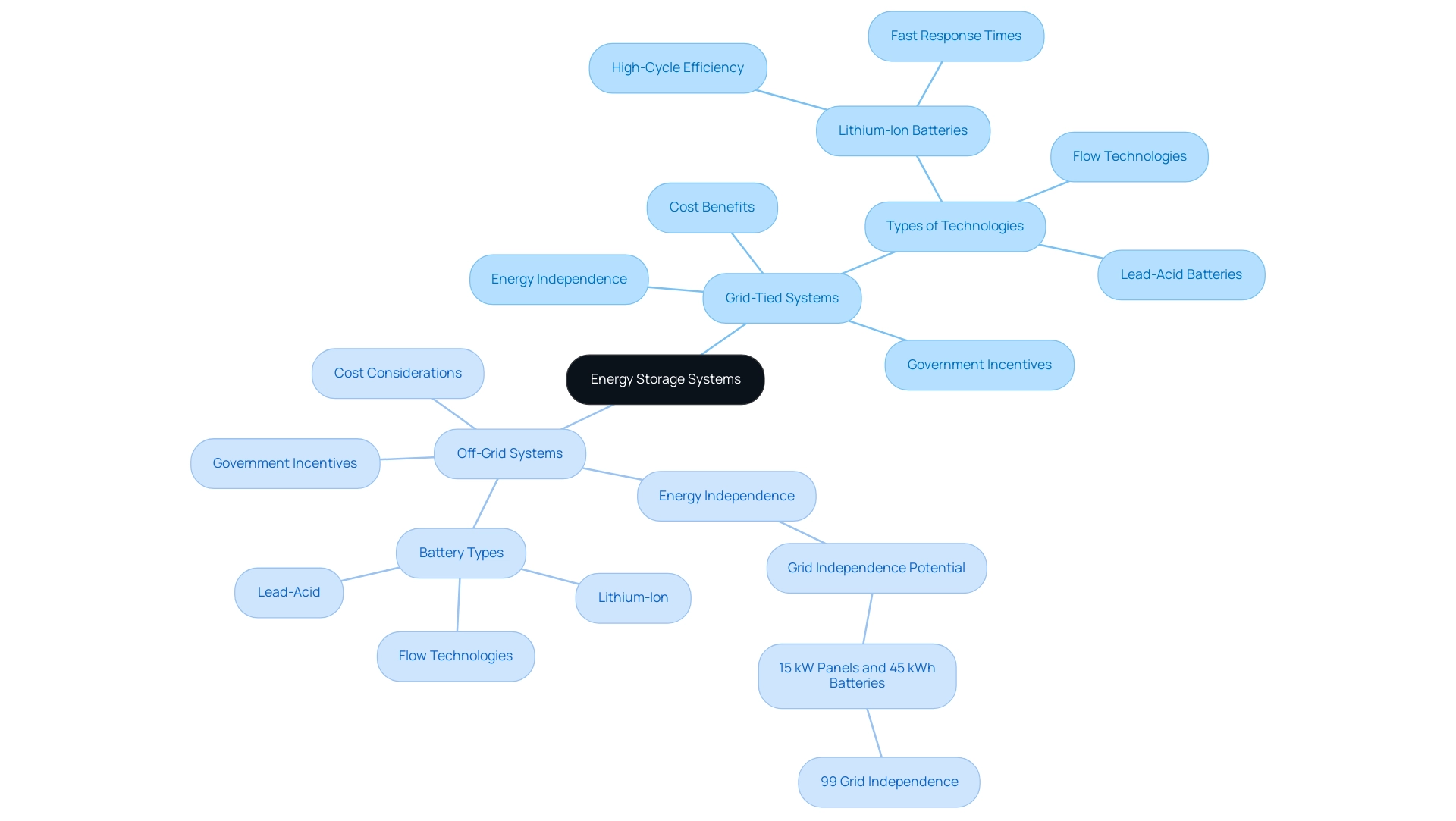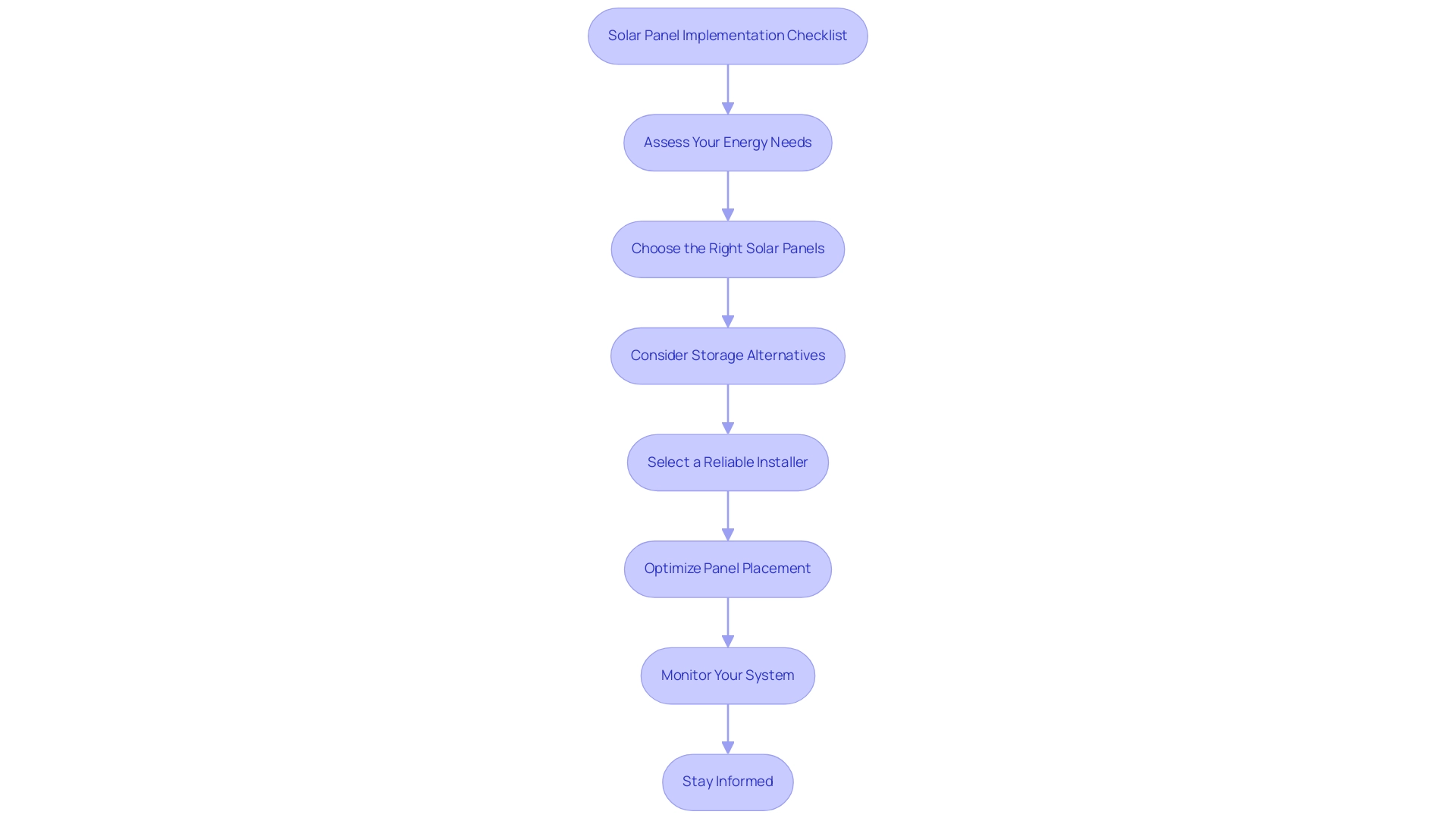Introduction
As homeowners increasingly turn to solar energy for a sustainable and cost-effective power solution, questions often arise about how to maximize the benefits of solar panels, especially when the sun sets. While it’s true that solar panels don’t generate electricity at night, the integration of energy storage systems, like batteries, opens up a world of possibilities.
By capturing excess energy produced during sunny days, these systems empower homeowners to harness solar power even after dark, ensuring that energy independence doesn’t have to pause with the setting sun.
This article delves into the essentials of solar battery storage, explores the differences between grid-tied and off-grid systems, and offers practical tips for optimizing solar panel placement.
Whether considering a new installation or looking to enhance an existing setup, homeowners will find valuable insights to help them make informed decisions about their solar energy journey.
Can Solar Panels Generate Energy at Night?
While photovoltaic panels are excellent for capturing sunlight to produce electricity, it’s important to remember that they don’t generate power at night. But don’t let this limitation reduce your excitement for renewable power! By incorporating storage solutions, such as accumulators, you can capture and retain the surplus power your panels produce on sunny days, which raises the question of how do solar panels store energy for night use.
This indicates you can still appreciate the advantages of solar energy even when it’s dark outside.
Recent advancements in solar storage technology, including lithium-ion, lead-acid, and flow systems, have made these options more efficient and affordable, allowing you to maximize your solar investment. Lithium-ion cells are recognized for their high efficiency and extended lifespan, making them a popular choice among homeowners. Lead-acid cells, while less costly, typically have a shorter lifespan and lower efficiency.
Flow systems provide unique benefits in scalability and longevity, but they can be more complex to install. As eco-conscious homeowners, it’s crucial to consider key factors when selecting a battery:
- Capacity
- Efficiency
- Lifespan
- Price
- Ecological benefits
For example, Shanhui Fan, a professor of electrical engineering, wisely points out,
Every time you’re outside, you’re actually doing it
— a reminder that embracing sunlight harnessing is part of a larger commitment to sustainability.
Moreover, statistics show that homeowners utilizing sunlight storage can save approximately $128 per year for each kW of capacity installed. This not only emphasizes the financial advantages but also highlights how storage solutions relate to the question of how do solar panels store energy for night use, improving your sunlight experience and ensuring dependable access during the night. With the expanding commercial and utility-scale photovoltaic market, setups defined as upwards of 1 MW highlight the rising significance of power storage.
As you evaluate your photovoltaic options, keep in mind that while panels may halt at night, you might wonder do solar panels store energy for night use, ensuring your power independence doesn’t have to! Numerous property owners are effectively utilizing energy storage systems to guarantee they possess electricity when it is most necessary, particularly in relation to how do solar panels store energy for night use. For instance, a case study involving a family in California revealed that after installing a lithium-ion power setup, they were able to sustain power access during peak usage periods, significantly lowering their electricity expenses.
Incorporating these solutions into your residence can greatly influence your power consumption and savings, making photovoltaic a sustainable and beneficial option. Therefore, when choosing an energy storage solution, consider options like the Tesla Powerwall for its efficiency, the more affordable yet reliable lead-acid options, or the innovative flow energy storage alternatives for long-term sustainability.
Understanding Solar Battery Storage for Nighttime Use
Photovoltaic storage units play an essential part in optimizing the advantages of your panel system by answering the question of how do solar panels store energy for night use by retaining surplus power produced during the day. While your solar panels operate diligently to capture sunlight, you may wonder do solar panels store energy for night use in storage devices for those evening hours when you require it most. Popular options for these storage solutions comprise lithium-ion and lead-acid types, each with its unique advantages.
- Lithium-ion cells, for example, are recognized for their high power density and longer lifespan.
- Lead-acid cells are generally more economical initially but may need more upkeep.
Significantly, Tesla Inc., Panasonic Corporation, and LG Energy Solution Ltd. are major participants in the residential storage market, recognized for their innovative power storage solutions. As you consider your options, it’s important to assess your specific energy needs.
Factors such as power source capacity, charging speed, and lifespan can significantly affect your experience. The average cost of lithium-ion cells is anticipated to reach approximately USD 82 per kWh by 2025, rendering them a more accessible option for homeowners. Moreover, findings from recent reports emphasize emerging patterns in accumulator usage, including how the automotive sector is investigating electric powertrains, which is affecting the adoption of storage technologies in renewable resources.
As per Frost & Sullivan, a 7.4 percent reduction in expenses is expected, ensuring that you select a battery that will deliver adequate power for your nighttime usage, which raises the question of how do solar panels store energy for night use, enabling you to enjoy the full capabilities of your renewable power setup. With government programs supporting renewable initiatives and popular cleaning services available to maintain your panels, as discussed in our recent posts, now is a great time to make the switch and invest in sustainable solutions.
Exploring Energy Storage Systems: Grid-Tied vs. Off-Grid
When considering power storage solutions, homeowners often ask how do solar panels store energy for night use when deciding between grid-tied and off-grid alternatives. A grid-connected arrangement links directly to the local utility network, enabling homeowners to sell surplus power back when their panels generate more than their household requires. This not only helps lower energy bills but also provides a reliable source of energy during low production periods.
In fact, the majority of homeowners in the U.S. have opted for grid-tied solar setups due to their convenience and cost benefits.
On the flip side, off-grid setups operate independently of the utility grid. These setups necessitate adequate power storage to satisfy all requirements, leading to the inquiry of how do solar panels store energy for night use, which can represent a considerable investment. For instance, a large system with 15 kW panels and 45 kWh of batteries can achieve grid independence 99% of the time, showcasing the potential of off-grid capabilities.
Homeowners considering this route must closely evaluate their power consumption patterns to understand how do solar panels store energy for night use. As energy analyst Gold Country Russ wisely points out, ‘In the end, efficiency isn’t the big question; what it costs you is.’ This sentiment highlights the significance of grasping both the upfront expenses and long-term savings related to each setup.
When choosing a solar power storage system, homeowners should consider whether and how do solar panels store energy for night use, in addition to capacity, efficiency, lifespan, price, and ecological benefits. The market provides various choices, including lead-acid, lithium-ion, and flow technologies, each with its own set of features and advantages. Significantly, lithium-ion batteries prevail in most U.S. utility-scale battery storage solutions (BESs), recognized for their high-cycle efficiency and rapid response times.
Furthermore, homeowners should investigate government programs that provide incentives and rebates, making renewable solutions more accessible and affordable. Furthermore, considering panel cleaning services can enhance the efficiency and longevity of energy systems, ensuring optimal performance. Ultimately, the decision should reflect personal power requirements and lifestyle choices, ensuring that homeowners make the most informed selection for their unique situation while exploring all available alternative energy options.
Optimizing Solar Panel Placement for Maximum Daytime Energy Capture
To ensure your energy panels capture the maximum amount of sunlight, it’s crucial to install them in locations that receive direct sunlight throughout the day. Here are step-by-step instructions for optimal installation:
- Assess your roof’s orientation; typically, south-facing roofs are ideal, as they tend to receive the most sun exposure with minimal shading from nearby trees or buildings.
- Consider the angle; a tilt between 30 to 45 degrees is often recommended for optimal performance, as optimal tilt angles can vary based on latitude and average insolation levels.
It’s also important to check for any obstructions that could shade the panels throughout the day. Recent data indicates that sunlight exposure in areas from 66°34′N to 66°34′S can rise considerably, highlighting the significance of geographical factors in power collection. Moreover, the National Renewable Resources Laboratory (NREL) estimates that an average of 3.3 million homes will either be constructed or need roof replacements each year, offering a remarkable opportunity for renewable power adoption—potentially contributing around 30 gigawatts (GW) of capacity annually.
A case study highlighted that while the initial payback period for investment in renewable energy may be around 6 years through savings on utility bills, the actual savings in the first year amounted to $2,933, suggesting a potential payback in about 9 years. Regular maintenance, including innovative cleaning solutions, is essential for enhancing efficiency and longevity. Additionally, when evaluating power storage, it’s essential to consider how do solar panels store energy for night use and select the appropriate photovoltaic cell.
Alternatives like lithium-ion cells provide high efficiency and longevity, making them a superb option for homeowners who want to understand how do solar panels store energy for night use. By thoughtfully considering placement, angle, and battery selection, homeowners not only enhance power capture but also improve power storage, making this system an even more effective and sustainable solution.
Checklist for Effective Solar Panel Implementation and Nighttime Use
Solar Panel Implementation Checklist
-
Assess Your Energy Needs: Start by calculating your average energy consumption. The average U.S. household uses about 10,500 kilowatt-hours (kWh) of electricity per year, with significant variations based on region and housing type.
Comprehending your requirements is essential for establishing the appropriate dimensions of your photovoltaic setup, especially as water heating constitutes 12% of residential site electricity usage.
-
Choose the Right Solar Panels: Take the time to research and select solar panels that boast high efficiency ratings and come with solid warranties. This ensures you’re investing in a reliable solution that will serve you well for years to come.
-
Consider Storage Alternatives: Reflect on various storage systems and their capacities, especially to understand how do solar panels store energy for night use. Popular types include lithium-ion cells, which provide high efficiency and longer lifespans, and lead-acid cells, which are more affordable but less efficient. As Hannah Bastawrose (Seeger) emphasizes,
Whether it is renewable, like photovoltaic power, or a diesel generator, it will determine how much power is coming from the grid and its cost.
A good battery can significantly reduce your reliance on the grid during off-peak hours, leading to the question of how do solar panels store energy for night use, which impacts your overall energy costs and enhances your energy independence.
-
Select a Reliable Installer: Choosing a licensed and experienced installer is key to ensuring proper installation and compliance with local regulations. This step can make a significant difference in the longevity and efficiency of your energy system.
-
Optimize Panel Placement: Install your solar panels in a location that receives maximum sunlight and at the optimal angle. This can significantly enhance the power your setup produces and aid in overall efficiency.
-
Monitor Your System: Utilize monitoring tools to track your energy production and consumption. Keeping tabs on your system allows you to make adjustments as necessary to maximize efficiency and save on costs.
-
Stay Informed: Finally, keep up with the latest advancements in solar technology and any incentives available in your area, especially for Long Beach renters. Programs such as the California Solar Initiative can provide rebates that help offset installation costs.
This knowledge will help you make the most of your investment, particularly since the average operating cost of household appliances—like the $87 for a typical refrigerator in 2020—can be significantly impacted by your energy choices.
Conclusion
Harnessing solar energy offers a pathway to sustainable living, but understanding how to maximize its benefits—especially during nighttime hours—is essential. Solar panels effectively capture sunlight during the day, yet without energy storage systems, their output halts once the sun sets. By integrating batteries, homeowners can store excess energy generated throughout the day, ensuring a continuous power supply even after dark. This not only enhances energy independence but also contributes to significant savings on electricity bills.
Choosing the right energy storage solution is crucial. With options like lithium-ion and lead-acid batteries each presenting unique advantages, homeowners must evaluate their specific energy needs, costs, and desired longevity.
- Grid-tied systems offer convenience and the ability to sell excess energy back to the grid.
- Off-grid systems provide complete independence, albeit with a more substantial investment in battery storage.
Moreover, optimizing solar panel placement can dramatically increase energy capture, making it vital to consider factors like orientation, angle, and potential obstructions. By following a comprehensive checklist for solar panel implementation, including careful assessment of energy needs and regular maintenance, homeowners can unlock the full potential of their solar energy systems.
Ultimately, the journey toward solar energy is one of empowerment and sustainability. Understanding the interplay between solar panels and battery storage opens the door to a future where energy independence is not just a dream but a tangible reality. With the right knowledge and tools, homeowners can confidently navigate their solar journey, ensuring that the benefits of clean energy extend well into the night.





